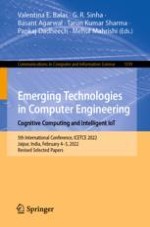2022 | Buch
Emerging Technologies in Computer Engineering: Cognitive Computing and Intelligent IoT
5th International Conference, ICETCE 2022, Jaipur, India, February 4–5, 2022, Revised Selected Papers
herausgegeben von: Prof. Valentina E. Balas, Dr. G. R. Sinha, Dr. Basant Agarwal, Tarun Kumar Sharma, Pankaj Dadheech, Mehul Mahrishi
Verlag: Springer International Publishing
Buchreihe : Communications in Computer and Information Science
